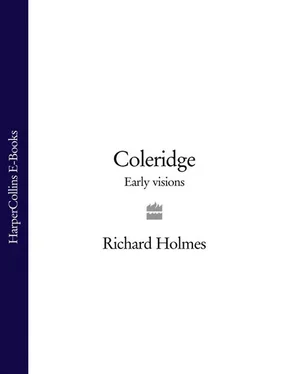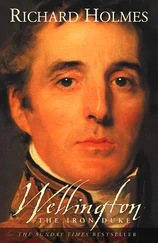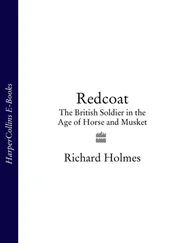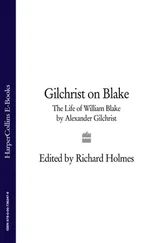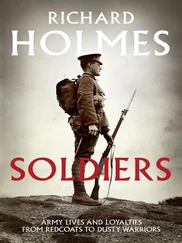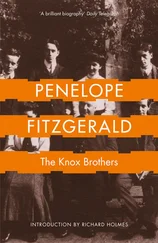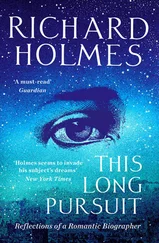It was amusing to Southey, but not to Coleridge. In his poetry it was to produce the recurring image of a lost or rejected child, for ever attempting to return home, or recover the feelings of home, or somehow – marvellously – to reinvent them.
The pluck and determination of his older brothers was exemplified by John, who had been in Calcutta since 1771, and within five years rose to the rank of lieutenant. His courage and generosity became legendary in the family. His vivid, good-hearted letters arrived regularly at Ottery throughout Coleridge’s boyhood, often bringing money. They could hardly have failed to fire Sam’s imagination. In 1775 a typical missive arrived from Monghyr, on the Ganges, a hundred miles south of the Nepalese border.
I left Calcutta about the end of April…You have no doubt heard of Monghyr, famous for its wild, romantic situation, and especially for its being the Montpellier of the East. About two miles from the garrison there is a Hotwell in which the water continually boils; the Natives esteem it sacred, and flock thither from all parts of the country to receive a Holy Sprinkling, as they imagine it has the Virtue of cleansing them from their sins… 27
It may have been glimpses like this that first turned Coleridge towards his lifelong fascination with travel books. James came to rely on John for help in his own military career, eventually receiving from him the sum of £1,000 to purchase a commission. Francis so worshipped John that he finally contrived to join him in India at the incredibly early age of twelve. John even had a remarkable plan for Sam to join him in India as a cadet; but this was to be forestalled by his own tragic death from malaria, at Tillicherry, in January 1787. He died penniless, having sent all his money home or lent it to fellow officers. 28
By the age of six, Sam’s obsessive reading had reached unhealthy proportions. Coleridge again described this with a keen eye on the young prodigy in the making. He had imported “all the gilt-covered little books” from his aunt’s every-thing shop at Crediton, and among them The Arabian Nights:
one tale of which (the tale of a man who was compelled to seek for a pure virgin) made so deep an impression on me (I had read it in the evening while my mother was mending stockings) that I was haunted by spectres, whenever I was in the dark – and I distinctly remember the anxious & fearful eagerness, with which I used to watch the window, in which the books lay – & whenever the Sun lay upon them, I would seize it, carry it by the wall, & bask, & read. 29
The childish mixture of fantasy and superstition is acutely recalled: the beautiful virgin who is also a fearful spectre; the relentless moving finger of the sun which is also a kind of benevolent, protecting power. Again, these are themes that Coleridge would carry into his adult poetry of his late twenties, in “Christabel” and the Ancient Mariner.
In his forties he was still recalling the impact of The Arabian Nights in his essays: “…I can never forget with what a strange mixture of obscure dread and intense desire I used to look at the volume and watch it, till the morning sunshine had reached and nearly covered it, when, and not before, I felt the courage given me to seize the precious treasure…” 30
Coleridge also saw himself as little Sam, becoming almost comically peculiar and precocious. “So I became a dreamer – and acquired an indisposition to all bodily activity – and I was fretful, and inordinately passionate, and as I could not play at any thing, and was slothful, I was despised & hated by the boys; and because I could read & spell, & had, I may truly say, a memory & understanding forced into almost an unnatural ripeness, I was flattered & wondered at by all the old women.” 31Here, incidentally, is the first glimpse of Coleridge the talker, ensconced in a circle of his clucking admirers. (He later told Godwin that he was “accustomed only to the conversation of grown persons”, and became “arrogant & conceited”.) 32
The Reverend John now intervened. With characteristic forthrightness he actually burnt the offending storybooks, and enrolled Sam in the King’s School where he remained a pupil to the age of nine. He soon “outstripped” all of his age. His schoolboy horizons opened, and there is evidence of much wandering about the town, and down by the River Otter, and to neighbouring houses, often in the company of Francis, with whom fraternal warfare continued. “Frank had a violent love of beating me – but whenever that was superseded by any humour or circumstance, he was always very fond of me – & used to regard me with a strange mixture of admiration & contempt – strange it was not – : for he hated books, and loved climbing, fighting, playing, & robbing orchards, to distraction.” 33
One memorable trip was to the Pixies’ Parlour, a mysterious sandstone cave beneath the roots of an ancient oak tree, in a field about a mile south of the town overlooking the river. It was a place of folklore – goblins, ghosts – where Sam bravely imitated his elders by carving his initials in the shadowy recess. It was a cave that reappeared many times in his poetry, and finally became an image of his lifelong search for esoteric knowledge:
Yea, oft alone,
Piercing the long-neglected holy cave,
The haunt obscure of old Philosophy,
He bade with lifted torch its starry walls
Sparkle, as erst they sparkled to the flame
Of odorous lamps tended by Saint and Sage. 34
As an undergraduate he was to go back to find those initials, entwined with those of his heroic brothers. *
Another visit was to Sir Stafford Northcote’s new country house, the Pynes, outside Ottery. Frank had fallen in love with the baronet’s daughter Maria, to whom he was later to send messages of devotion from India. But Sam was taken by a different kind of recondite beauty – the splendid, polished, Georgian spiral staircase. Years later, when trying to explain the complex structure of his essay-collection, The Friend , with its expanding themes and “interposed” lighter pieces of diversion, or “landing-places”, he suddenly recalled his first, awesome impression of the great house.
Before all other objects, I was most struck by the magnificent staircase, relieved at well proportioned intervals by spacious landing-places, this adorned with shewy plants, the next looking out on an extensive prospect through the stately window with its side panes of rich blues and saturated amber or orange tints: while from the last and highest the eye commanded the whole spiral ascent with the marbled pavement of the great hall from which it seemed to spring up as if it merely used the ground on which it rested. My readers will find no difficulty in translating these forms of the outward senses into their intellectual analogies… 35
In fact Coleridge himself always had the greatest difficulty with the “architectural” structure of his prose books, as his readers found to their cost. They were to be less like solid Georgian staircases, and far more like the visionary, suspended, self-circling stairways of Piranesi’s famous engravings. Something of this seems already foreshadowed in the childhood sense – recorded with such visual accuracy – that on looking down over the banisters from the top of Northcote’s spiral stairs, the entire structure seemed independent of the ground, simply springing up above it into the air, magically and alarmingly unsupported.
Most fondly recalled of all were the endless expeditions down to the placid, rippling waters of the Otter, which meander through low red-earthed banks and shallow shingle spits, six miles down to the sea at Budleigh Salterton:
Читать дальше
